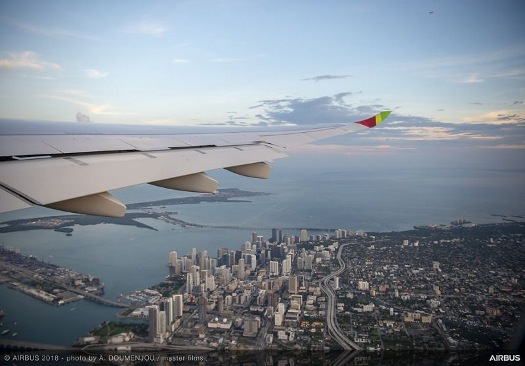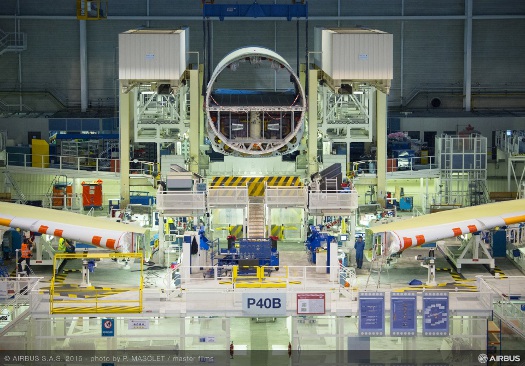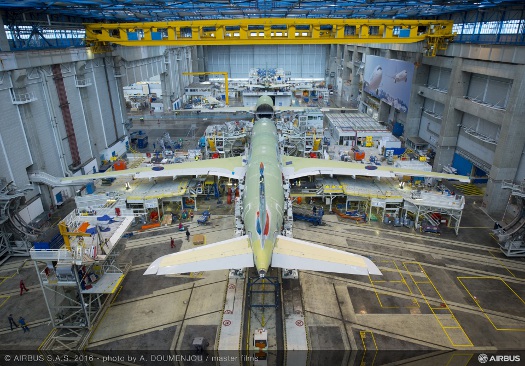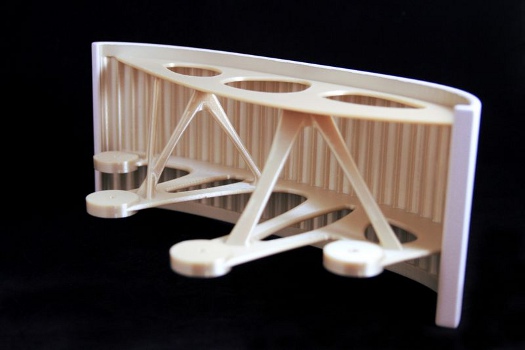 |
| July 17, 2018 | Volume 14 Issue 27 |
Designfax weekly eMagazine
Archives
Partners
Manufacturing Center
Product Spotlight
Modern Applications News
Metalworking Ideas For
Today's Job Shops
Tooling and Production
Strategies for large
metalworking plants
Toolbox:
Airbus execs talk about finding the right metals and composites
Questions and answers with lead Airbus materials buyers.

Major components of the fuselage and wings of the A350 XWB, such as this A350-900 test aircraft on display at the 2018 ILA Berlin air show, are made of carbon fiber-reinforced plastic and manufactured in the German city of Stade. It is the furthest-flying aircraft in the industry.
After nearly a century of dominance as the material of choice for aircraft, metals are seeing increased competition from composite materials in use on such aircraft as Airbus' widebody A350 XWB jetliner. Are the days of metal aircraft numbered? Two experts from Airbus' Material Procurement division explain that it's more complicated than that. Raphael Duflos is Airbus' lead metallics buyer, and Cedric Thibout is the company's lead buyer for composites.
Duflos: Metallic materials are our legacy -- the aviation industry been building aircraft out of metals ever since wood and canvas were phased out. We know a lot about their properties, and there are plenty of suppliers who are also very familiar with working with them.
Generally speaking, we shape metals by taking away what we don't need -- it's a subtractive process, and that means a lot of waste. The "buy-to-fly" ratio isn't good. Depending on the metal, only 10 to 20 percent of what we buy ends up in use on an aircraft; the more complicated the design, the worse the buy-to-fly becomes.

The first production A330-900, painted in the livery of launch operator TAP Air Portugal, flies above the airline's home city of Lisbon, Portugal, on July 6, 2018. This plane incorporates the latest-generation Rolls-Royce Trent 7000 engines along with aerodynamic improvements -- including new composite Sharklet wingtip devices -- as well as increased lift and reduced drag.
Thibout: Composites, which usually means reinforced plastics, are almost the complete opposite. They're new, and there is very little waste indeed. Composite materials also can be modified to "tweak" their properties fairly easily, and designs can be very flexible.
The flipside is that we have fewer suppliers to choose from, and the materials and manufacturing processes can be expensive. The technologies involved are evolving, so we can expect prices to drop and expertise to become more common, but for now, composite materials aren't cheap.

The elements of an A330neo widebody jetliner start coming together at the final assembly line, or FAL, adjacent to Toulouse-Blagnac Airport in southwestern France. The A330 family integrates the latest developments from the A350 XWB and A380 aircraft families to maintain its position as the best in its class.
What considerations go into choosing one material over another?
Thibout: Material buyers are involved at the earliest stages of the design process. Sometimes it's best to explore a number of possibilities for a part, and doing that properly involves complicated considerations. It isn't just about raw materials and manufacturing -- we also need to take into account costs for development, testing, certification, servicing, and the end of the component's life cycle.
Duflos: That isn't easy. We've even been involved in the design of new metallic alloys to do the exact job that we want -- we have to explore all realistic possibilities thoroughly to be as sure as possible that the decisions made are the best for the company and our customers. Choosing the right material is about balancing performance, weight, and cost.
That's why we work with multi-functional teams and play a coordinating role -- ultimately, the decisions are collective, and all the Airbus divisions involved have to agree on the way forward. I'm focused on metals, and Cedric looks after composites, but we're both part of Materials Procurement, helping the wider business choose materials wisely.
How does Airbus ensure quality, particularly with a new alloy or composite?
Duflos: Testing to check that a material has the properties we require is absolutely key. Even though we choose reliable suppliers and trust them, we still regularly push materials to their limits in testing to be sure that they're safe and that we meet our responsibilities. This is expensive, but big data could open up new opportunities.
Thibout: When we buy a composite or a metallic alloy, our testing lets us be certain that the supplier used the right mixture of materials and followed the right process to give us the properties we agreed on. Using their data, we'll be able to check all this more easily -- we won't replace destructive testing completely, but we can envision fewer sessions.

With its major structural components assembled, an Airbus A330neo begins to take shape at the final assembly line in France. In addition to housing a delivery center for completed aircraft, the Toulouse-Blagnac site is also home to final assembly lines for the A320, A350 XWB, and A380 jetliners.
How is material procurement changing?
Duflos: We're launching the Integrated Metallic Material Management project, or IM3. It's an Airbus-driven approach that will see us challenging every part throughout our entire supply chain. We'll be working alongside suppliers to check that we're making the best possible decisions on materials and processes at every stage.
Thibout: It will be a massive job, but big data has made it possible for the first time. We're also preparing the future generation of aircraft by ensuring that the best suppliers and partners are on board, cooperating with us to develop the best materials and technologies at the most competitive total cost of ownership.
Will composite materials replace metals?
Thibout: I don't think so. There are areas of an aircraft where the strength and familiarity of metals make sense. Take the A350 XWB: Much of the wing was perfectly suited for composites, but for the underwing pylons that support the jet engines, titanium had the properties that made it our top choice. Another factor is what happens when materials mix -- aluminium fasteners corrode quite quickly when they are in contact with composite panels, so we use titanium instead. The increase in composites has actually stimulated demand for titanium.

By 3D printing spacer panels for use aboard Finnair's A320 aircraft, Airbus created bio-inspired panels 15 percent lighter than if made using conventional production methods.
Duflos: There will always be a balance needed, and even that will continue to evolve. Now, composites can be used to make much more complex parts than metals, and they also have the edge as far as waste is concerned. However, we're seeing more and more work being done using powdered metals in additive layer manufacturing. For now, the powders are far more expensive than plate metals. But as prices come down, we could see metals becoming a viable alternative in areas where composites are currently the preferred option. The idea of metal as a legacy material that relies on a subtractive process is starting to blur.
Source: Airbus
Published July 2018
Rate this article
View our terms of use and privacy policy
